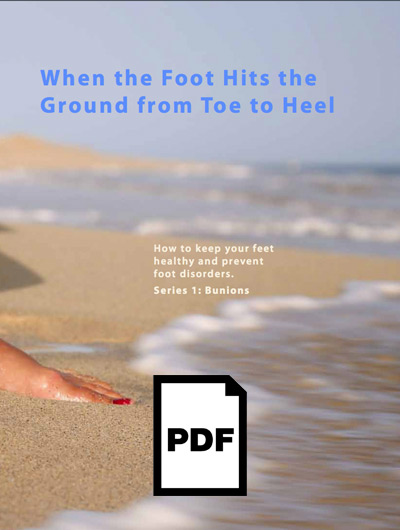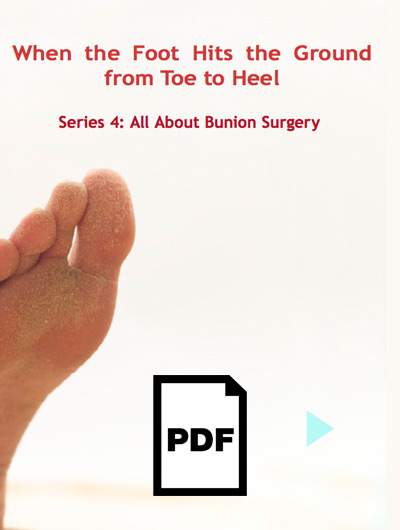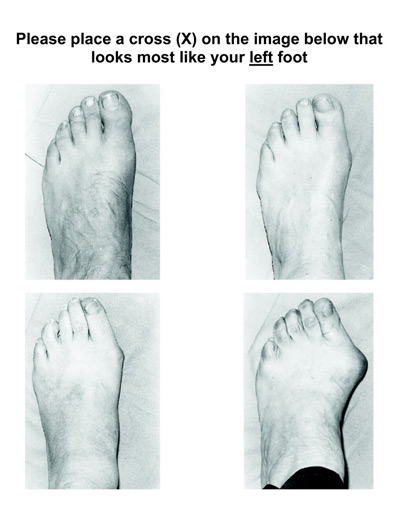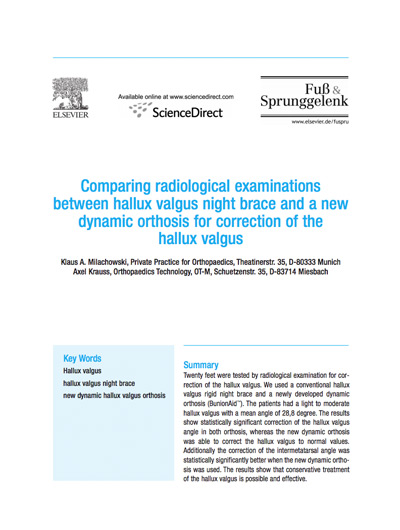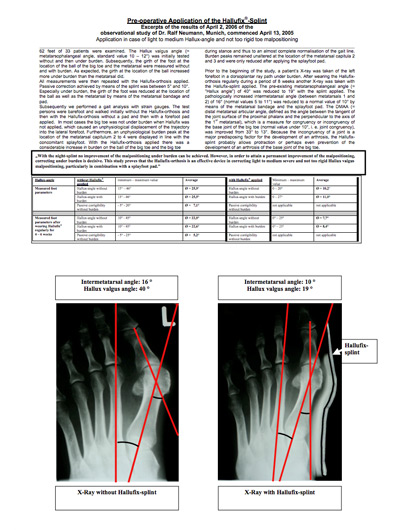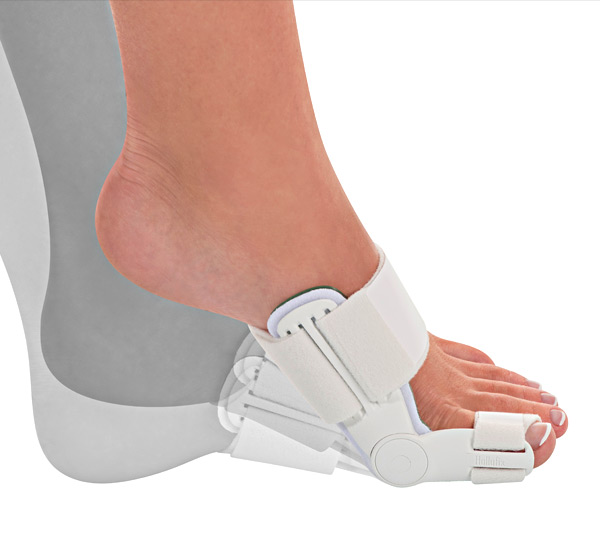Try Bunion Aid with your Patients
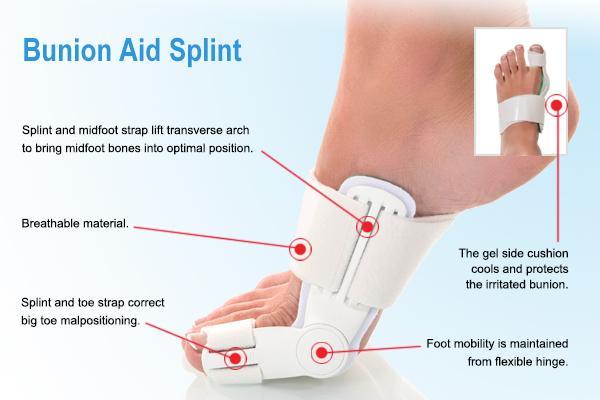
Bunion Aid relieves bunion pain and is clinically proven to straighten the big toe in mild to moderate Hallux valgus and maintain post-surgical fixation. We invite you to try Bunion Aid on one of your patients.
Post-surgical care: After bunion surgery, your patient will be able to quickly return to an active lifestyle by wearing Bunion Aid during the post-surgical healing process.
Preventative care: With daily compliance, a patient with mild to moderate bunions will witness reductions in the metatarsophalangeal angle and intermetatarsal angle between the big toe and 2nd toe.
Patient Literature
To assist in educating your patients, we have created downloadable pages about all aspects of the Bunion Aid® line of products. Either print them yourself, or request a patient packet of pre-printed literature.
Bunion Information eBooks
Alpha Orthotics publishes complimentary downloadable eBooks for patient education. The series, “When the Foot Hits the Ground from Toe to Heel,” educates your patient about the biomechanics of the foot and provides an overview of common foot ailments, popular treatments, and bunion surgery procedures.
Manchester Assessment Guide
Why not provide your patients with a way to measure the severity of their bunion prior to their visit to your office?
Until recently, only physicians used the Manchester scale to measure the medial deviation of the metatarsophalangeal (MTP) joint with respect to the big toe. However, according to a recent study, the accuracy of patients using the scale to self-assess bunion severity is acceptable.
Download the Manchester Bunion Scale, a simple clinical screening tool for assessing the severity of Hallux valgus (bunions). It provides an easy way to identify the degree to which one may have bunions prior to seeking bunion treatment or medical advice.
U.S Patent
Orthopaedic device for correcting abnormal positions of the toes
United States Patent 7396338
Abstract:
The invention concerns an orthopaedic device for the correction of incorrectly positioned toes, having a fastening provision (8a) in the region of the big toe, a fastening provision (8b) in the region of the central foot and a flexible splint (9), extends between the fastening provisions (8a, 8b) along the inner side of the foot, and in which the flexible splint (9) is formed as a hinged splint, articulated in the direction of flexion and extension of the toe or toes.
Bunion Aid Clinical Studies
Post-operative Use of the Bunion Aid® Splint as Compared to a Rigid Night Splint

Source: Orthopedics, “Aid for hallux valgus – Germany’s secret common condition,” Medical Special 6/06 February 2007
A study in Munich demonstrates a pronounced reduction of postoperative rehab-time and very good stabilization of the surgical correction of the toe’s position following a bunionectomy.
A study comparing the postoperative use of the Bunion Aid® splint system with a rigid night splint in 56 cases displayed: Significant improvement in gait was observed in the 5th postoperative week, reflected in an up to 13% improvement in the rolling behavior of the first ray. Rolling behavior (load on the first ray) had also improved significantly (15%). The clinical/radiological Hallux angle displays no difference in both groups.
Advantages of the Bunion Aid® splint is significantly improved rolling behavior and an early load on the first ray. The postoperative gait of the patients using Bunion Aid® is much better than the comparison group.
Pre-operative Application of the Bunion Aid Splint
Observational study of Dr. Ralf Neumann, Munich, Germany
This study proves that the Bunion Aid® orthosis is an effective device in correcting mild to moderate and not too rigid Hallux valgus malpositioning, particularly in combination with a metatarsal pad.
62 feet of 33 patients were examined after wearing the Bunion Aid® splint regularly during an eight week period. The X-rays (before and after this period) showed the pre-existing metatarsophalangeal angle of 40° was reduced to 19° with the splint applied. The intermetatarsal angle (between metatarsals 1 and 2) of 16° was reduced to a normal value of 10° by means of the metatarsal strap and pad.
Dynamic Splint for the Conservative Treatment of Light to Moderate Hallux valgus

Orthopaedic Private Practices, Munich, Germany
The study shows that the dynamic splint, Bunion Aid®, is effective in correcting the malpositioning of the foot in case of mild to moderate Hallux valgus.
The effect of the Bunion Aid® splint was tested on 59 patients during a period of six weeks. Along with the determination of the Hallux valgus angle at the beginning and the end of the study, a gait analysis with a strain gauge was performed in barefoot gait and without the splint. On ten of these patients, an x-ray of the forefoot in Dorsoplantar ray path was performed under load at the beginning of the study and after eight weeks of wearing the splint.
The results demonstrate that the pre-existing metatarsophalangeal angle of an average 38° could be reduced to 18.5° by wearing the Bunion Aid® splint. The intermetatarsal angle was reduced from an average of 18° to within normal values of 10.5° and the distal metatarsal articular angle (DMAA) improved from 32° to 12.5°.
Comparing radiological examinations between Hallux valgus rigid night brace and a dynamic orthosis, Bunion Aid® splint, for correction of the Hallux valgus
Due to providing more comfort as a day and night splint and the simultaneous correction of the splayfoot, the Bunion Aid® dynamic splint is significantly more suitable for conservative correction of Hallux valgus than the standard night splints.
Until the development of the Bunion Aid® hinged splint, conservative measures meant using a Hallux valgus night splint for therapy and post-operative treatment. However, there are disadvantages to wearing a rigid night splint: local pressure load, lack of comfort, and the inability to walk even a few steps while wearing it. Additionally, the rigid night splint does not correct splayfoot, one of the root causes of Hallux valgus.
In cooperation with the Fraunhofer Institute, a dynamic splint, Bunion Aid®, was developed to actively correct mild to moderate Hallux valgus. Radiological studies of twenty feet showed the following results:
The initial Hallux valgus angle was an average of 28.8°. The night splint allowed a statistically significant reduction to 18.3° and the newly developed Bunion Aid® dynamic splint corrected the malpositioning back into normal values with an average of 11.6°. The initial average intermetatarsal angle DI – DII was an average of 16°. The rigid night splint enabled an insignificant correction to 13°, whereas, with the dynamic Bunion Aid® splint the intermetatarsal angle was also normalized at a value of 10.2°.
Improvement of Body Balance and Gait Stability by Means of the Bunion Aid® Foot Splint
Orthopaedic Private Practices, Munich, Germany
By wearing the Bunion Aid® splint, the dynamics, statics, and total balance of the body are optimized and gait stability is improved.
Position and orientation of the body section were measured with an optoelectronic device. Only those test persons who had a hallux abduction angle of less than 19° were included in the study. The study concluded:
The jerk in knee is significantly lower with the Bunion Aid® splint than in the constrained condition.
The hip is significantly closer above the heel with the Bunion Aid® splint than in the constrained and normal conditions.
The following trend is observed, but significance is low: The larger the angle corrected by the Bunion Aid® splint, the larger the hip/foot joint angle.
The test persons walked on the treadmill under three different conditions:
1. Barefoot
2. With constrained toes in stylish shoes with no heel
3. With Bunion Aid® splint holding the big toe angle straight.
Medical Professional Testimonials
Here are a few of the medical professionals who are using Bunion Aid in their practice. Let us know if you want to be a part in our community and be featured as one of our “Foot Experts” on our web site. Also, we would like to include your practice in our listing of medical practices with a link to your site.
Bunion Aid Patient Reviews
We have built a loyal following of patients who are using Bunion Aid. Here is what they have to say about Bunion Aid.






